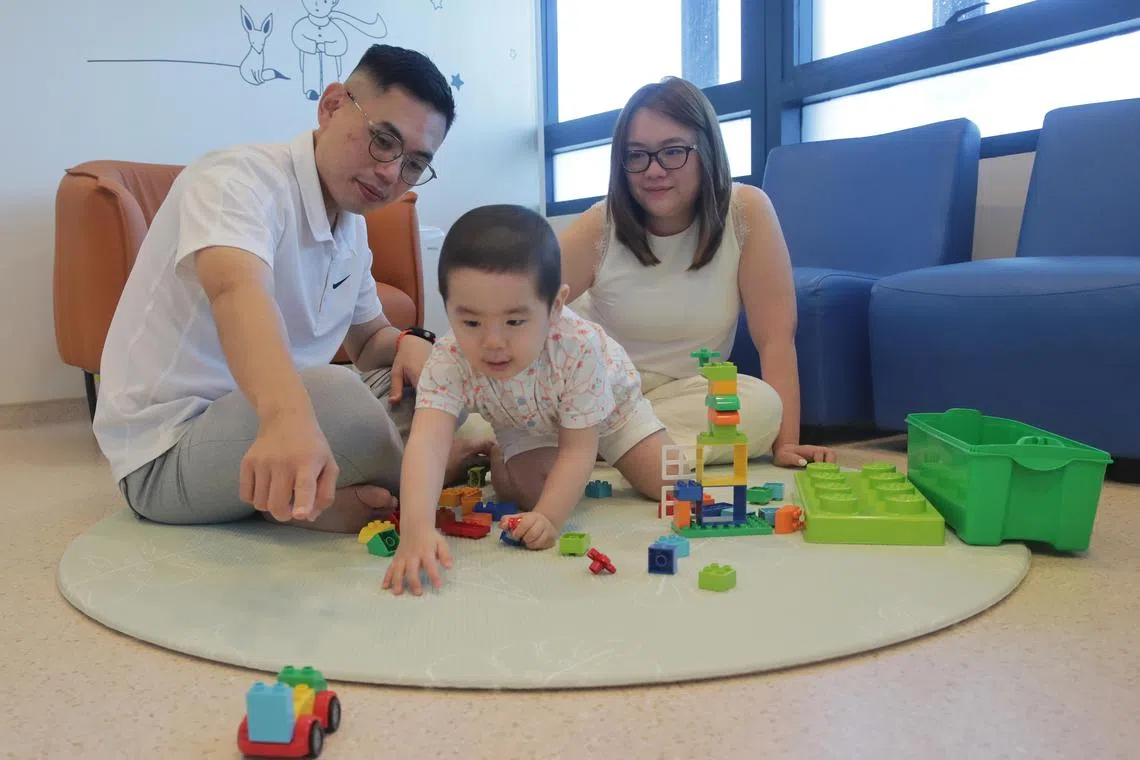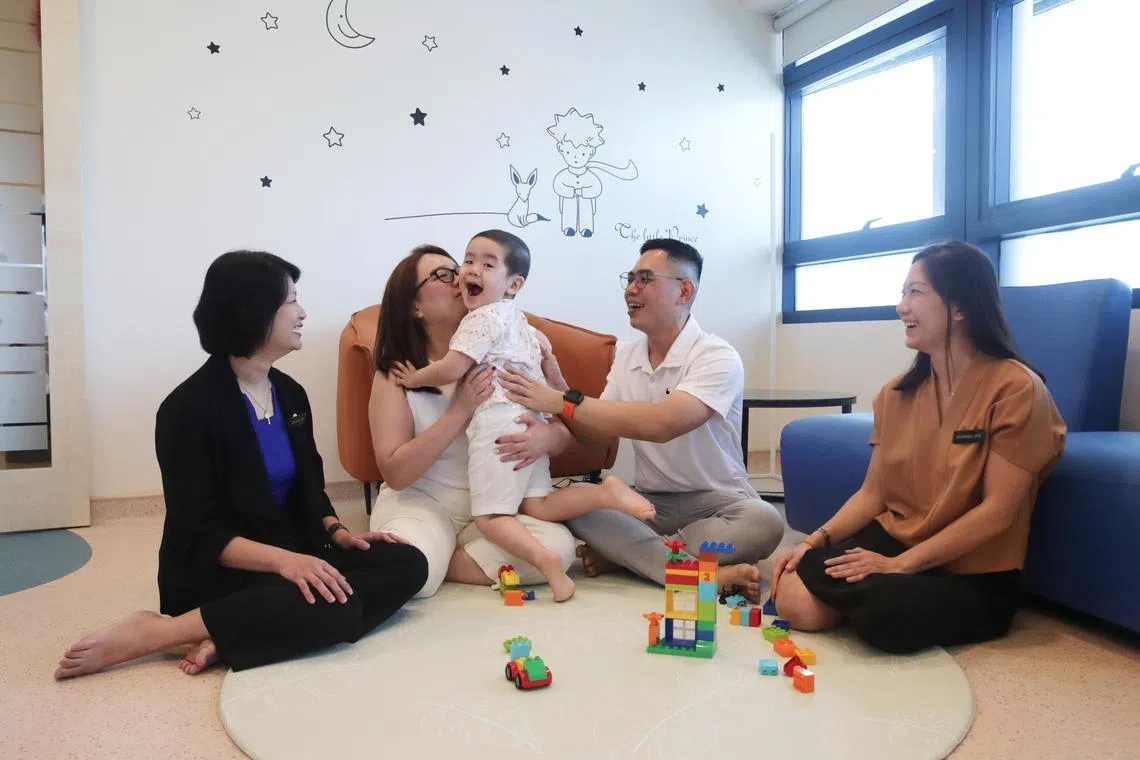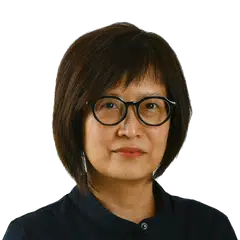New treatment saves toddler with aggressive leukaemia after chemotherapy failed to work
Sign up now: Get ST's newsletters delivered to your inbox

(From left) Civil servant Michael Teo and his wife Adriana Koh with their son Mathias.
ST PHOTO: GIN TAY
Follow topic:
SINGAPORE – Two-year-old Mathias kept coming down with high fever. Then his family noticed bruises on his inner thighs.
“We thought he was being punished in childcare,” said his father, Mr Michael Teo, 39, a civil servant.
Following a second visit to a general practitioner, the family was advised to take the child to KK Women’s and Children’s Hospital (KKH).
By then, tiny blood spots resembling pinpricks had begun appearing on his legs, said the boy’s mother, Ms Adriana Koh, 34, who works in the talent acquisition field.
Mathias was taken to KKH on a Sunday last April as his parents were afraid he might have caught dengue fever.
A blood test revealed that the toddler had an alarmingly elevated white blood cell count, and he was promptly admitted to the children’s intensive care unit (ICU).
Two days later, his parents learnt from the doctors that he had leukaemia – a cancer that starts in the cells of the bone marrow where blood cells are made. The doctors recommended chemotherapy.
“It was a shock. We have no family history (of leukaemia), and he was born healthy and had been healthy since,” said Mr Teo.
Leukaemia is the most common childhood cancer in the world. In Singapore, about 150 children are diagnosed with cancer every year.
About two-thirds are leukaemia cases, according to KKH.
In the ICU, Mathias would scream in fear each time the doctors had to draw his blood for various tests. He also screamed for his parents when they had to leave the ward for the medical team to perform a bone marrow biopsy.
Mr Teo said they wanted so much to alleviate the pain their son was feeling but felt completely helpless. “We broke down outside the ICU. We hugged each other.”

Associate Professor Joyce Lam (far left) and senior consultant of haematology/oncology service at KK Women’s and Children’s Hospital Michaela Seng (far right) with the family.
ST PHOTO: GIN TAY
The toddler did not respond to the first round of chemotherapy and was put on a stronger dose in the second stage of the treatment.
He was constantly hungry and would ask his grandmother for food every half hour. Said Mr Teo: “He had to eat very fresh food... so she had to make the fresh food.”
Mathias became weak and bloated until “we almost couldn’t recognise him”, Mr Teo added.
When the doctors assessed the boy’s response to the first five weeks of chemotherapy, they confirmed that he had an aggressive form of leukaemia – pre-B acute lymphoblastic leukaemia involving the KMT2A gene.
“In Mathias’ case, the genetic changes found in the leukaemia cells are known to be high risk and not as responsive to conventional chemotherapy,” said Associate Professor Joyce Lam, a senior consultant at KKH’s haematology/oncology service and medical director of the hospital’s cell processing laboratory.
Worldwide, such patients have poor prognosis, with up to 80 per cent succumbing to the disease.
As Mathias did not respond to chemotherapy, his doctors decided on a new and promising treatment known as CAR T-cell therapy, followed by a stem cell or bone marrow transplant.
CAR, or chimeric antigen receptor, T-cell therapy uses the body’s own immune system to help fight the cancer.
It was approved in Singapore in March 2021.
In the treatment, T cells – a type of white blood cells that help fight infections – are genetically altered in a lab and infused back into the patient.
The re-engineered T cells – now known as CAR T cells – acquire a new receptor that enables them to locate and destroy the cancer cells.
These CAR T cells were manufactured by the Cell and Gene Therapy Facility at the Health Sciences Authority.
Following the CAR T-cell treatment, KKH’s Teo Sok Yong and Goh Cheng Liang Childhood Cancer Lab, which opened in early 2022, processed the healthy donor cells for Mathias’ stem cell transplant last August.
About 10 per cent to 15 per cent of leukaemia cases require “extraordinary efforts to treat”, said Dr Michaela Seng, a senior consultant at KKH’s haematology/oncology service, and one of the doctors caring for Mathias.
“So CAR T is now the new tool, which basically spares the (patient) a lot of the toxicities, either by replacing a whole chunk of strong chemo or even replacing transplant completely – but in his case, we had to do both.”
Still, Mathias was spared from more months of high-dose chemotherapy, Dr Seng added.
The strategy also meant he could avoid radiotherapy exposure to his whole body, reducing the risk of acute and chronic conditions in later life, including earlier onset of these conditions compared with his peers in adulthood, she said.
Such radiation exposure would have been necessary in his case in a traditional transplant situation, Dr Seng added.
“Now we can differentiate which cancer needs less treatment, which one needs more, and for those that need more, (we ask ourselves), do we have better-designed therapies to avoid some of the side effects?” she said.
Mathias became the youngest patient at KKH to have undergone the CAR T-cell therapy. The one-time treatment is generally known to be costly. The Kymriah CAR T-cell therapy, for instance, comes with a reported price tag of US$475,000 (S$633,000).
As for the type of CAR T-cell treatment that Mathias had, it is currently available to the hospital’s patients only as part of research.
When Mathias was ready for the transplant one month after the CAR T-cell therapy, his father went to Singapore General Hospital to donate his stem cells. After his cells were harvested, they were quickly sent to the KKH lab for processing before they were transplanted into Mathias.
After the transplant, Mathias suffered from intense vomiting and diarrhoea for about a week, his father said.
“He would vomit and then immediately start eating. If he was eating, it was a good sign.”
For some six months till earlier in 2023, Mathias was back at the hospital every week for the doctors to monitor his cancer. It is now in complete remission, and the frequency of the monitoring will gradually decrease with time.
The couple, who have an older daughter, continue to worry about their son. But after that ICU episode, they have resolved to be more positive for his sake, said Mr Teo.
“We put aside our sadness… and focused on his treatment.
“At least there is a solution. After coming (to KKH) and talking to other parents, we learnt that as long as the doctors tell us there is a solution, it’s good news.”
This article has been edited for clarity.


